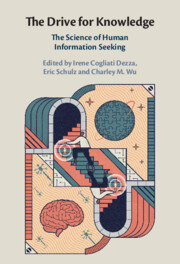Book contents
- The Drive for Knowledge
- The Drive for Knowledge
- Copyright page
- Contents
- Figures
- Tables
- Notes on Contributors
- Preface
- Part I What Drives Humans to Seek Information?
- Part II How Do Humans Search for Information?
- Part III Which Machinery Supports the Drive for Knowledge?
- Chapter 9 Information-Seeking in the Brain
- Chapter 10 Attention as Rational Choice
- Chapter 11 Seeking Inner Knowledge
- Chapter 12 Edgework
- Future Challenges
- Index
- References
Chapter 12 - Edgework
Viewing Curiosity as Fundamentally Relational
from Part III - Which Machinery Supports the Drive for Knowledge?
Published online by Cambridge University Press: 19 May 2022
- The Drive for Knowledge
- The Drive for Knowledge
- Copyright page
- Contents
- Figures
- Tables
- Notes on Contributors
- Preface
- Part I What Drives Humans to Seek Information?
- Part II How Do Humans Search for Information?
- Part III Which Machinery Supports the Drive for Knowledge?
- Chapter 9 Information-Seeking in the Brain
- Chapter 10 Attention as Rational Choice
- Chapter 11 Seeking Inner Knowledge
- Chapter 12 Edgework
- Future Challenges
- Index
- References
Summary
Most theories of curiosity emphasize the acquisition of information. Yet, recent advances from philosophy and cognitive science suggest that it may be time to complement the acquisitional theory of curiosity with a connectional theory of curiosity. This alternative perspective focuses on the actions of the knower in seeking relations among informational units, laying down lines of intersection, and thereby building a scaffold or network of knowledge. Intuitively, curiosity becomes edgework. In this chapter, we dwell on the notion of edgework, wrestle with its relation to prior accounts, and exercise its unique features to craft alternative reasons for curiosity’s value to humanity. In doing so, we find that the notion of edgework offers a fresh, flexible, and explanatory account of curiosity. More broadly, it uncovers new opportunities to use the lens of science to examine, probe, and interrogate this important dimension of the human experience.
Information
- Type
- Chapter
- Information
- The Drive for KnowledgeThe Science of Human Information Seeking, pp. 259 - 278Publisher: Cambridge University PressPrint publication year: 2022
References
Accessibility standard: Unknown
Why this information is here
This section outlines the accessibility features of this content - including support for screen readers, full keyboard navigation and high-contrast display options. This may not be relevant for you.Accessibility Information
- 3
- Cited by
